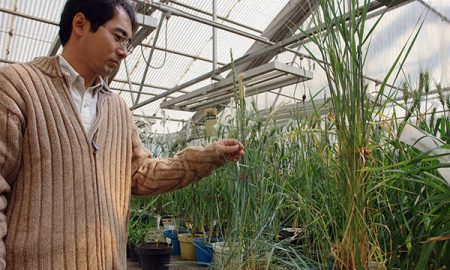Nitrogen-efficient crops on the horizon: Can we grow more with fewer emissions?
By Mike Listman/CIMMYT
EL BATAN, Mexico (May 17, 2017) – Through a natural, affordable alternative to farmers’ heavy use of nitrogen fertilizers, science now offers an option to boost crop productivity and dramatically reduce greenhouse gas emissions, according to the authors of a report that will appear this week in the journal Plant Science.
The new study describes certain plants that possess a trait known as biological nitrification inhibition (BNI), by which they suppress the loss of nitrogen (N) from the soil and improve the efficiency of its uptake and use by themselves and other plants.
The authors, who form part of a new BNI research consortium, propose transferring the BNI trait from those plants to critical food and feed crops, such as wheat, sorghum and Brachiaria range grasses.
“Nearly a fifth of the world’s fertilizer, for example, is deployed each year to grow wheat and the crop only uses about 30 percent of the nitrogen applied,” according to Guntur Subbarao, a researcher with Japan’s International Research Center for Agricultural Sciences (JIRCAS) and lead author of the study.

“If BNI research is successful, it would turn wheat, the world’s most widely-grown food crop, into a super nitrogen-efficient crop,” he explained. “Farmers would spend far less on fertilizer and nitrous oxide emissions from wheat farming could be reduced by as much as 30 percent.”
Excluding changes in land use such as deforestation, annual greenhouse gas emissions from agriculture each year are equivalent to as much as 5.8 billion tons of carbon dioxide (CO2), or 11 percent of the total emissions from human activity (Smith et al. 2014).
Nitrogen fertilizers are a major source of agricultural emissions. About 70 percent of N applied to crops in fertilizers is either washed away or flushed into the air as nitrous oxide (N2O), a greenhouse gas 300 times more potent than CO2.
“The most widely grown crop on the planet, wheat is a major nitrogen user and N2O emitter,” said Hans Braun, director of the global wheat program at the International Maize and Wheat Improvement Center (CIMMYT). “BNI technology is one of several options we’re pursuing to reduce nitrogen losses from wheat farming, but more funding is needed.”
The Plant Science study also mentions high-BNI forage crops, such as certain tropical Brachiaria grasses that produce brachialactone, a powerful BNI chemical.
The grasses can be eaten by cattle, while reducing N20 emissions and improving soil fertility for other crops grown in rotation on the same land, according to Michael Peters, leader of the tropical forages program at the International Center for Tropical Agriculture (CIAT).
“It may be counter-intuitive to many, but growing BNI Brachiaria to feed cattle can actually help reduce greenhouse gas emissions from livestock production,” said Peters, adding that unlocking BNI capacity in other crops would help reduce nitrogen fertilizer use across the board, benefitting farmers and the environment at large.
Work on BNI-enabled sorghum is also under way at the International Crops Research Institute for the Semi-Arid Tropics (ICRISAT).
But scientists at CIMMYT and ICRISAT say that BNI-enabled food crops will be a few years in coming, because it is difficult and costly to transfer the genetically-complex BNI trait into elite crop varieties while preserving high yield potential and other desirable qualities.
Subbarao and others are calling for major research investments to have high BNI food and forage crops grown widely across the globe by 2050 and thus help to meet the goal of limiting global temperature increases to 2 degrees Celsius above pre-industrial levels.
“Dramatically reducing nitrous oxide emissions from agriculture requires a complex, integrated approach that includes more precisely calculating and applying fertilizer doses,” Subbarao said. “But the beauty of BNI technology is that it works with and reinforces biological processes, and all you’ll need to do is sow a seed.”
According to Masa Iwanaga, the president of JIRCAS, BNI technology typifies the transformation needed in the current agricultural model and practices, to meet 21st century food production challenges.
“Feeding a global population projected to exceed 9 billion by 2050 will place a tremendous strain on agri-food systems and the environment.” Iwanaga said. “At the same time, agriculture is not merely a commodity-producing industry, but part of a larger ecosystem that offers life support and services to human society.”
FOR MORE INFORMATION OR FOR INTERVIEWS, CONTACT
Mike Listman
Communications officer, CGIAR Research Program on Wheat
Email: m.listman@cgiar.org
Tel (office): +52 (55) 5804 7537; Mobile: +52 (1595) 114 9743
CIMMYT – The International Maize and Wheat Improvement Center (www.cimmyt.org) – is the global leader in publicly-funded maize and wheat research and related farming systems. Headquartered near Mexico City, CIMMYT works with hundreds of partners throughout the developing world to sustainably increase the productivity of maize and wheat cropping systems, thus improving global food security and reducing poverty. CIMMYT is a member of the CGIAR System and leads the CGIAR Research Programs on Maize and Wheat and the Excellence in Breeding Platform. The Center receives support from national governments, foundations, development banks and other public and private agencies.
Led by JIRCAS, the BNI research consortium includes the organizations mentioned above as well as the CGIAR Research Programs on Climate Change, Agriculture and Food Security (CCAFS), Dryland Cereals, Livestock and Fish, Maize, and Wheat, and the Institute of Ecology and Environmental Sciences, University of Paris, Diderot, France; the Center for Ecology, Evolution and Environmental Changes, University of Portugal; Nanjing Agricultural University, China; the Indian Institute of Millet Research (IIMR), Hyderabad; the Department of Crop Production and Ecology, SLU, Uppasala, Sweden; the Advanced Analysis Center and the Hokkaido Wheat Research Station, both of the National Agriculture and Food Research Organization (NARO), Japan; and the National Institute for Agro-Environmental Sciences (NIAES), Japan.




